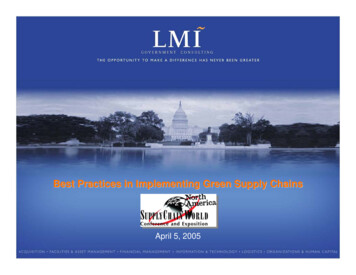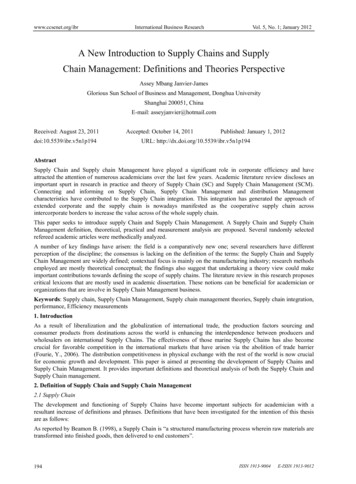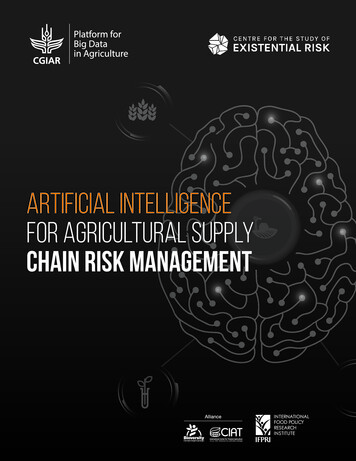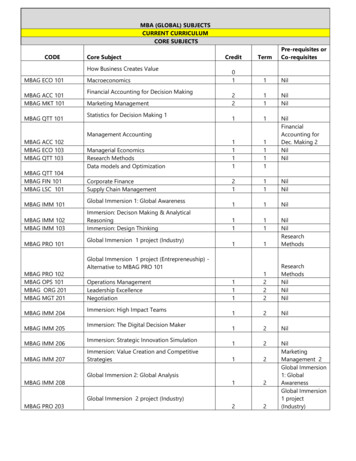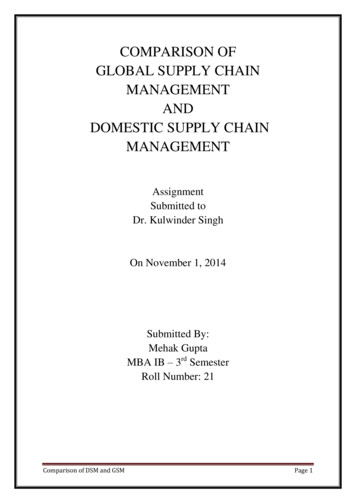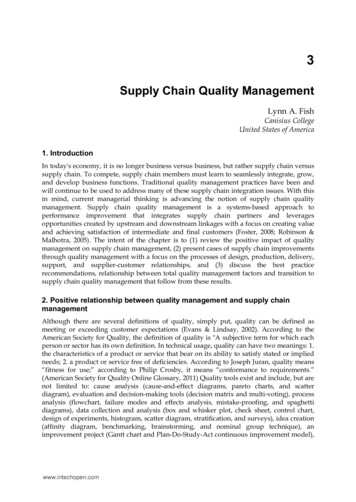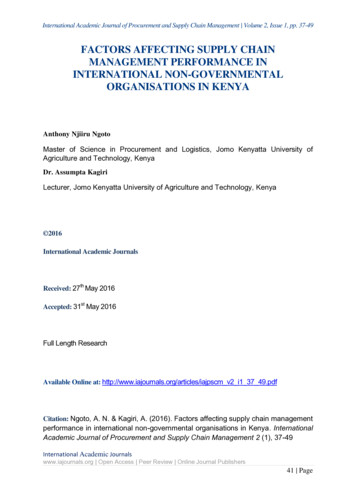
Transcription
International Academic Journal of Procurement and Supply Chain Management Volume 2, Issue 1, pp. 37-49FACTORS AFFECTING SUPPLY CHAINMANAGEMENT PERFORMANCE ININTERNATIONAL NON-GOVERNMENTALORGANISATIONS IN KENYAAnthony Njiiru NgotoMaster of Science in Procurement and Logistics, Jomo Kenyatta University ofAgriculture and Technology, KenyaDr. Assumpta KagiriLecturer, Jomo Kenyatta University of Agriculture and Technology, Kenya 2016International Academic JournalsReceived: 27th May 2016Accepted: 31st May 2016Full Length ResearchAvailable Online at: http://www.iajournals.org/articles/iajpscm v2 i1 37 49.pdfCitation: Ngoto, A. N. & Kagiri, A. (2016). Factors affecting supply chain managementperformance in international non-governmental organisations in Kenya. InternationalAcademic Journal of Procurement and Supply Chain Management 2 (1), 37-49International Academic Journalswww.iajournals.org Open Access Peer Review Online Journal Publishers41 Page
International Academic Journal of Procurement and Supply Chain Management Volume 2, Issue 1, pp. 37-49ABSTRACTEfficient supply chain management has aneffect on the overall internal performance ofany organisation. Current economic crisisand competitiveness of global organisationincreases its importance even further.Organizations adopt numerous businessimprovement methodologies to improve thebusiness performance. Manufacturers andresearchers have noted a number ofproblems regarding supply chain activitiesin their research and practice. This researchproject was centred on a survey of thechallenges facing effective implementationof supply chain management in NonGovernmental organisations and it hasfocused on International Humanitarian Nongovernmental organisations in Kenya.Supply chain management efficiency andeffectiveness has profound implications onany organization’s ability to meet itscustomer’s demands, its reputation, and itsoverall financial success. There is need forhumanitarian organisation to adopt bestsupply chain management practises that willmeet the overall strategy which is to achievevalue for money and to develop world classprocurement systems and practices andensure quality and timely supplies tobeneficiaries.The study is taken against thebackdrop of the importance of nongovernmental organisations in adoptingefficient supply chain management systemsbearing in mind the volume of goods andservicespurchasediscontinuouslyrising.The aim of this study is to access thefactors affecting supply chain managementperformance within international nongovernmental organisations in Kenya. Theobjectives of the study were; establishing theeffect of strategic supplier partnerships,contract management and informationcommunication technology on supply chainmanagement performance. The study isdescriptive by design. This study wasconducted on a population of supply chainmanagers in 302 registered INGOs that havebeen active over the past 5 years to August2014. Out of these, the researcher randomlysampled 172 supply chain management staffof INGO to which the questionnaires wereadministered. Data was collected throughthe questionnaire which was organized toanswer set objectives in the study. Data wasanalysed using descriptive statistics i.e.frequency distributions and measures ofcentral tendencies. The results of the surveywere presented using tables, charts andgraphs. The SPSS computer software wasused to aid the analysis. Multiple regressionanalysis was also used to determine therelationships between the variables and theeffective implementation of SCM. Keyfindings: the study revealed that supplyrelationship positively affects supply chainmanagement performance though manyNon-governmentalorganisationsarechallenged by the complexity of networks inmanaging flow.The study established thatcontract management affects supply chainmanagement performance, few Nongovernmental organizations use updateddocumented policy to monitor contracts. Theresearcher also noted that informationsharing is a vital tool in supply chainmanagement performance however someNon-governmental organizations are stillusing paper work as a mode ofInternational Academic Journalswww.iajournals.org Open Access Peer Review Online Journal Publishers37 Page
International Academic Journal of Procurement and Supply Chain Management Volume 2, Issue 1, pp. 37-49communication while telephone is the mostcommon mode of communication.Key Words: Supply Chain s,ContractManagement,Information SharingINTRODUCTIONSupply chain management (SCM) represents a significant change in the way that organizationsview themselves and has witnessed values created through the integration and coordination ofsupply, demand and relationships in order to satisfy customers in an effective and profitablemanner both in the private and public sectors. Supply chain management is applied bycompanies across the globe due to its demonstrated results such as delivery time reduction,improved financial performance, greater customer satisfaction, building trust among suppliers,and others. According to Ronnqvist and Weintraub (2008), companies resort to supply chainpractices to improve their performance. Recently, Aid Agencies have become increasinglyinterested in how Supply chain and their stakeholders impact on the organizational strategy(Walker and Wendy, 2006).Successful implementation of SCM is seen as closely dependent upon the need for breakingdown barriers not only between internal departments and business processes, but also acrosscompanies within the whole supply chain (Vollman et al., 2005). Its success is also associatedwith the challenging development of a new culture based on empowerment on-going sharedlearning and continuous improvement. Projects implemented by NGO’s involve the use of donorfunds to achieve specific objectives for the benefit of the public. In Kenya, NGOs are licensedand regulated by the NGO Coordination Board. These organisations supplement governmentefforts to improve the living standards through implementation of diverse donor funded projects.However, majority of such donor funded projects often run into hurdles in the course ofimplementation. Most of these hurdles relate to supply chain management policies and the needto adhere to donor guidelines which do not necessarily result in effective utilization of funds andefficiency in service delivery (Kirugu, 2011).There is need for humanitarian organisation to adopt best supply chain management practicesthat will meet the overall strategy which is to achieve value for money and to develop worldclass procurement systems and practices and ensure quality and timely supplies to beneficiariesKovacs (2004). The study is taken against the backdrop of the importance of Non-governmentalorganisations in adopting efficient supply chain management systems bearing in mind thevolume of goods and services purchased is continuously rising. For instance, the United Nations(UN) procured in the year 2000 around 40 % more than in 1996. The purchase of relief items(not services) at the UN amounts around 60 % of total procurement expenditures (Taupiac,2001).International Academic Journalswww.iajournals.org Open Access Peer Review Online Journal Publishers38 Page
International Academic Journal of Procurement and Supply Chain Management Volume 2, Issue 1, pp. 37-49Non-governmental organizations (NGOs), like many other companies, are oftentimes faced withthe challenge of managing their supply chains with dwindling financial resources, a lack ofexpertise, and insufficient personnel. Most of these companies are surprised to learn that use ofbest practices in procurement processes can actually help them operate more efficiently whilereducing their operating costs by as much as 60%.An efficient but flexible humanitarian reliefsupply chains is the key subject in disaster relief, discussed from academics as well aspractitioners (Kovác & Spens, 2007).STATEMENT OF THE PROBLEMSupply chain management efficiency and effectiveness has profound implications on anyorganization’s ability to meet its customer’s demands, its reputation, and its overall financialsuccess (Ambe, 2009). Supply chain management inefficiency presents the single biggestopportunity for operational inefficiencies in any organization Feldman (2003). There has been arise in complaints by the public, professionals and other stakeholder’s about the supply chainmanagement performance within the Non-Governmental organisations in Kenya. The opinionof many is that supply chain management within the institutions way below the stakeholders’expectations (Transparency International, 2014). A strategic partnership between a supplier andthe buyer emphasizes direct, long-term association and encourages mutual planning and problemsolving efforts (Gunasekaran et al, 2001).Institutions in Kenya have for a long time been struggling with serious issues of poor suppliermanagement where cases of malpractices have been reported since there the relationship existingis not based on trust and commitment which has affected the level of service delivery offered andmore so efficiency and effectiveness of the supply chain management (World Bank, 2013).Institutions information sharing is rigid because of the bureaucratic structures and overrelianceon manual ways of communication which has affected supply chain management performancebecause of delay of information from one entity to the other (KNBS, 2014). Whereas it is clearthat execution of supply chain management has an impact on the outcome of donor fundedprojects in Kenya, the question still remains as to which specific factors affect the performanceof the supply chain management that have the greatest effect. This study thus sought toinvestigate the factors affecting supply chain management in INGO’s operating in Kenya. Toaddress this question, the study specifically focused on the impact of strategic supplierpartnership, contract monitoring and control, as well as information sharing.OBJECTIVES OF THE STUDYThe general objective of the study was to assess the factors affecting supply chain managementin international non-governmental organizations in Kenya.International Academic Journalswww.iajournals.org Open Access Peer Review Online Journal Publishers38 Page
International Academic Journal of Procurement and Supply Chain Management Volume 2, Issue 1, pp. 37-49SPECIFIC OBJECTIVES1. To analyze the effect of strategic supplier partnership on supply chain management ininternational non-governmental organizations in Kenya2. To establish the effect of contract management on supply chain management ininternational non-governmental organizations in Kenya3. To determine the effect of information sharing on supply chain management ininternational non-governmental organizations in KenyaTHEORETICAL REVIEWBounded Rationality TheoryEconomics of organizations recognize that individuals are subject to bounded rationality (Simon,1951, 1955, 1957, 1961). This means that individuals are limited in their scope to act fullyrationally because of limitations relating to both information at their disposal and theircomputational skills. This makes the writing of complete contracts impossible - hypotheticallysuch contracts perfectly solve the coordination and motivation problems. Put another way, in thereal world, contracts are incomplete, being costly to create and implement, and imperfect insolving the coordination and motivation problems. These limitations mean that new contracts arebeing continually determined and old ones adapted, sound project contract management thatincludes monitoring and control systems that are necessary for effective supply chainmanagement in any successful institution.The Principal - Agent FrameworkThis approach classifies the people or parties involved in transactions. Transactions can becharacterized by an imbalance of information, so there is likely to be a dependency relationshipbetween the parties involved. In particular, one party to the transaction often has either moreinformation and/or better bargaining power than the other. On this basis the theory identifies twotypes of parties to a transaction. The principal is a party who wishes to secure provision of somegood or service but does not have the necessary specialized knowledge, skills or assets. Theprincipal employs an agent to undertake this task and in the process delegates some control tothat party (Grossman & Hart, 2001). In their study Zhenxin et al., (2001) illustrates the benefitsof supply chain partnerships based on information sharing that is effective through use ofinformation systems in organisation such as the INGOs. The study further found out that a closerelationship means that channel participants share the risks and rewards and have willingness tomaintain the relationship over the long term through formulation of strategic supplierrelationship.International Academic Journalswww.iajournals.org Open Access Peer Review Online Journal Publishers39 Page
International Academic Journal of Procurement and Supply Chain Management Volume 2, Issue 1, pp. 37-49CONCEPTUAL FRAMEWORKStrategic Supplier Relationship-Existing supplier relationship-Supplier selection process- Strategic contracting methodsContract Management-Internal controls-Contracts completed in time-Monitoring and Evaluation of ProjectsSupply Chain ManagementPerformanceTargetsCost reductionEffectivenessInformation Sharing-Nature of information exchange- Mode of communicationIndependent VariablesDependent VariableSCM performance is defined as the operational excellence to deliver leading customerexperience (Simchi-Levi et al., 2003). Theoretically, as described by Mentzer et al (2001), asupply chain can be defined as "a set of three or more organizations directly linked by one ormore of the upstream and downstream flows of products, services, finances, and informationfrom a source to a customer." The main goal and important aspect of supply chain is leveragingthe expertise, experience, skills and capabilities of the supply chain professionals who comprisethis competitive network (Mentzer et al, 2001). Beamon (2006) mentions some features presentin effective performance measurement systems and these include the following: inclusiveness(measurement of all pertinent aspects), universality (allows for comparison under variousoperating conditions), measurability (data required are measurable), and consistency (measuresconsistent with organization goals). Also, the strategic goals include key elements such as themeasurement of resources (generally cost), output (generally customer responsiveness) andflexibility. Stevens (2001) states that to build up an integrated supply chain requires themanagement of material flow from three perspectives: strategic, tactical, and operational.From these perspectives, the use of systems, facilities, and people must be seen as a whole andwork in a coordinated manner. He also mentions that a company can measure the supply chainperformance by inventory level, service level, throughput efficiency, supplier performance, andcost. Lear-Olimpi (2001) also stated that logistics play an important role in pursuing supplychain excellence which will lead to improved business performance (Oliver, 2004). Logistics isdefined as the responsibility to design and administer systems to control movement andgeographical positioning of raw materials, work-in process, and finished inventories at the lowesttotal cost (Bowersox et al., 2007). The research of Autry, Zacharia and Lamb (2008) establishthat logistics must be focused on the coordination and collaboration of activities, logistics socialInternational Academic Journalswww.iajournals.org Open Access Peer Review Online Journal Publishers40 Page
International Academic Journal of Procurement and Supply Chain Management Volume 2, Issue 1, pp. 37-49responsibility, strategic distribution planning, and technology and information systems. SupplyChain Management aims to link all the supply chain agents to jointly cooperate within the firmas a way to maximize productivity in the supply chain and deliver the most benefits to all relatedparties (Finch, 2006). Adoption of Supply chain management practices in industries has steadilyincreased since the 1980s.Over the past decade, the traditional purchasing and logistics activities have emerged and shiftedinto broader strategic approach to materials and distributions management known as supplychain management. It is currently a major issue as organizations realize the substance ofdeveloping an integrated connection with their suppliers and final users. The performance of afirm depends not only on how efficiently it cooperates with its direct partners, but also on howwell these partners cooperate with their own business partners. Network theory (NT) can be usedto provide a basis for the conceptual analysis of reciprocity in cooperative relationships (Oliver,2004). Here, the firm’s continuous interaction with other players becomes an important factor inthe development of new resources (Haakansson and Ford, 2002). Relationships combine theresources of two organizations to achieve more advantages than through individual efforts.There are apparently significant gaps in the academic area of supply chain management in Kenyaon how supply chain can be effectively managed in order to satisfy customers in an effective andprofitable manner by INGOs. No conclusive study has been carried out yet that has establishedon the factors affecting supply chain management in INGOs. There seems to exist a congruenceof ideas on the whole phenomenon of supply chain management. As pointed out by Kimani(2013), Mwirigi (2014), Quesada (2007), among other scholars on the subject under study, thekey factors affecting supply chain management are supplier partnership, Contract management,and information technology communication. There is no standardized prescribed form throughwhich INGO incorporate these practices while executing the supply chain management. It shouldbe however noted that there could be other factors other than these that also impact on supplychain performance of INGOs. This provides room for further research in this area to provide acomprehensive body of knowledge that can profoundly benefit donors, implementing partners’policy makers and academicians.RESEARCH METHODOLOGYResearch DesignThis study adopted a descriptive survey design. Descriptive research design was used as it hadmerits such a researcher having no control over the variables and only reported what washappening. Descriptive design was found appropriate because it involved collecting data in orderto answer pertinent questions concerning the current status of subjects under study. The researchdesign provides facts and suggestions on major connections between the variables. This designInternational Academic Journalswww.iajournals.org Open Access Peer Review Online Journal Publishers41 Page
International Academic Journal of Procurement and Supply Chain Management Volume 2, Issue 1, pp. 37-49therefore adopted for this study as it enabled the researcher to obtain a cross-referencing data andsome independent confirmation of data, as well as arrange the options.Population of the StudyThe population of the study comprised of the supply chain managers in 302 INGOs registered bythe NGO Coordination Board to operate in Kenya as at 30th August 2014. Respondents weresupply chain managers in the INGOs.Sample Size and Sampling TechniquesThis study was conducted on a population of supply chain manager in 302registered INGOs thathave been active over the past 5 years to August 2014. Specific respondents were selectedthrough the random sampling technique. This research used the cluster random samplingtechnique to yield the study’s sample size using the formula described by Israel (1992). Thisformula was used for calculating the sample size so as to ensure 95% confidence level, 5% errormargin and a precision rating of 0.5. The sample size thus comprised 172 supply chain managersin INGOs.Data CollectionThe study used both primary and secondary data. Data collection was be done through sendingquestionnaires via email to respondents, then following up with a phone call to ensure receipt ofthe questionnaire by the respondents. The questionnaires were self-administered, wherebyrespondents completed the questionnaires by themselves and then submit their responses viaemail. Secondary data was obtained to supplement primary data by referring to existing officialreports and document form the named entities, journals, other empirical researches in the areaand any other relevant document from the libraries and internet. Questionnaires were used toobtain information about the population because they save time, are economical in terms ofmoney, convenient in that respondents can respond based on the contents, and easier toadminister. The questionnaire consisted of both closed and open ended questions to address thespecific objectives of the study. The open ended questions gave the respondents freedom toexpress their opinions. Prior to the actual study, a pilot survey was done to determine thefeasibility of the data collection instrument. The pilot survey brought out the weaknesses if anyof the questionnaire and the survey techniques (Kothari, 2004). It enables the researcher to assessthe questions validity and reliability of data that was collected. It also helped to determinewhether the method of data analysis is appropriate. The number of people to pilot test thequestionnaire depends on the research question(s), the objectives and size of the research project.This number is also dependent on the variations in the population; different scholars havedivergent views on the number to pretest the questionnaire. Saunders et al (2012) postulates thatnumber of 10 for a small survey are ideal. While Mugenda and Mugenda (2008) argue that thenumber the number should be large and a pretest sample of between 1% and 10% is goodInternational Academic Journalswww.iajournals.org Open Access Peer Review Online Journal Publishers42 Page
International Academic Journal of Procurement and Supply Chain Management Volume 2, Issue 1, pp. 37-49depending on the sample size. A sample of 5 % respondents that is 7 was selected to pilot test thequestionnaire for this research.Data Analysis and PresentationAfter the data collection, the data obtained from the research instruments was analysed by use ofdescriptive statistics (frequencies and percentages), as well as inferential statistics. Pearsoncorrelation coefficient and bi-variate correlation coefficient were used in this study to indicateone-on-one association between each of the independent variables to the dependent variable,while holding other factors constant. Multiple regression analysis was used to determine therelationships between the variables and the effective implementation of SCM. The coefficient ofdetermination (R-Square) resulting from the linear regression was used to determine thegoodness of fit. Percentages were used to determine sample distribution across variousdemographic variables while mean scores of the variables were used to determine the extent towhich certain factors are challenges to effective implementation of the SCM. Quantitative datawas presented in form of frequencies distribution tables, percentages and bar graph to present theinformation. While qualitative data, common items was obtained in data collected and clusteredin a patterned order so as to identify variables that depict general concepts and differences andwas presented descriptively.RESEARCH RESULTSThe analysis was based on 138 out of the 172 questionnaires received from the respondents fullyfilled which accounted to 80.2% response rate. A pilot survey was done to determine thefeasibility of the data collection instrument. Chronbach alpha was used to test reliability of thedata collection instrument. A Chronbach alpha 0.76 was obtained after pilot testing the researchinstrument this was considered to be sufficient.Strategic Supplier PartnershipAll the respondents (100%) unanimously agreed that indeed, supplier relationship with theorganisation affect supply chain management performance. majority of the respondents agreedthat early supplier involvement is practised to develop the supplier expertise as shown by a meanscore of 3.6875, suppliers are paid promptly to enhance good relationship with the organisationsas shown by a mean score of 3.5729, long term relationships with suppliers improves supplychain performance as shown by a mean score of 3.5521 and that long term relationship withsupplier has yielded better quality of goods and services to the organisation as shown by a meanscore of 3.5208. However, the respondents neither agreed nor disagreed that new suppliers aresubjected to an intensive supplier appraisal during their selection as shown by a mean score of3.4896 and vendor rating for existing suppliers is done to assess their performance regularly asshown by a mean score of 3.4583. These findings concur with Matthew (2008) who establishedthat as global markets grow increasingly efficient, competition no longer takes place betweenInternational Academic Journalswww.iajournals.org Open Access Peer Review Online Journal Publishers43 Page
International Academic Journal of Procurement and Supply Chain Management Volume 2, Issue 1, pp. 37-49individual businesses, but between entire value chains. The challenges that hinder supplier’s longterm relationship with the International Non-Governmental in Kenya include managing flows ina network like a supply chain is a major challenge due to the complexity of the network, theproliferation of products that flow through this network, and the presence of multiple decisionmakers who each own and operate a piece of this network and optimize a private object function.The international NGOs also experience challenges of framework contracting, proficiency in ITapplications, negotiation skills and records management.Contract ManagementAll (100%) of the respondents reiterated that indeed the contract management systems ininternational NGOs affect supply chain management performance. Majority of the respondentsindicated agreement with that all the suppliers of goods and services are contracted throughapproved contracting tools as shown by a mean score of 3.6354, supply chain staffs are involvedin contract monitoring and control processes as shown by a mean score of 3.5729 and theorganization always monitor and control the contracts execution as shown by a mean score of3.5313. On the other hand the respondents remained neutral on that the contact and monitoringcontrol processes used in the organizations are reviewed and updated regularly as shown by amean score of 3.4651 and that documented policy determines decision making on contractperformance and monitoring as shown by a mean score of 3.4583. On other aspects of contractmanagement that in their opinion that can affect performance of supply chain management intheir organization, the respondents indicated that the departments of supply chain managementhave made integration of man power and changes reflecting the change grounds for letting manycontracts which are very conversant in various categories of skills, which vary from time to timedepending on the demand. Department require INGOs to supply data on their manpower forvarious purposes, such as data compliance, or competence to execute certain contracts whileproviding this data, companies have led to develop inventories of their personnel by variouscategory classifications.Information SharingAll the respondents unanimously agreed that information sharing in their organisation affectssupply chain management performance in the international NGOs in Kenya. This is a clearindication that supply chain management includes coordination and collaboration with channelpartners such as suppliers, intermediaries, third-party service providers and customers. Majorityof the respondents agreed that the organization is connected to efficient internet network asshown by a mean score of 3.5104 and the supply chain staffs are conversant with the use ofmaterial requirement planning in the organization as shown by a mean score of 3.5104. Inaddition, the respondents indicated neutrality with that Electronic Data Interchange is used in theorganization, telephone is the most common mode of communication in the organization,payment of suppliers is done electronically, communication in the organization is purelyInternational Academic Journalswww.iajournals.org Open Access Peer Review Online Journal Publishers44 Page
International Academic Journal of Procurement and Supply Chain Management Volume 2, Issue 1, pp. 37-49electronic with no paper work and delays in communication mostly affects supply chainmanagement performance in the organization as shown by mean score of 3.4583, 3.3953, 3.0930,3.0698 and 3.0698 respectively. These results are in agreement with those of Brynjolfsson andHitt, (2000) who indicated that successful implementing of strategies results from integratingand coordination of information technologic innovations, production processes, marketing,financing and personnel. The respondents indicated that supply chain collaborative efforts shouldreach across the entire supply chain to help streamline essential processes such as productdevelopment and pricing, as well as reduce costs and improve responsiveness to customerdemand.Supply Chain Management PerformanceAn overwhelming majority (60.1%) of the respondents reiterated that the performance of supplychain management in their organisations was satisfactory, while 39.9% of them opined that theperformance of supply chain management in their organisations was not satisfactory. Therespondents agreed that supply chai
International Academic Journal of Procurement and Supply Chain Management Volume 2, Issue 1, pp. 37 -49 International Academic Journals www.iajournals.org Open Access Peer Review Online Journal Publishers . Jomo Kenyatta University of Agriculture and Technology, Kenya 2016 International Academic Journals Received: 27 th May 2016 .




